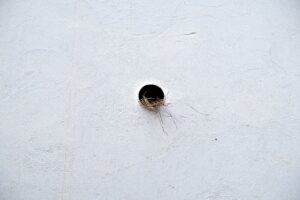How do Birds Get in Vents and What to do About It
Birds finding their way into your home’s vents can cause various problems, from creating noise disturbances to causing damage and health hazards. Understanding how these feathered intruders gain access to vents and taking appropriate action to address the issue is essential for maintaining a safe and comfortable living environment. Learn some of the ways birds enter vents and practical tips on how to effectively prevent and address this common nuisance.

Entry Points
Birds can enter vents through a variety of entry points, including:
- Damaged or missing vent covers: Vents with damaged or missing covers provide easy access for birds seeking shelter or nesting sites.
- Gaps and openings: Small gaps or openings around vent openings, siding, or roofing materials can allow birds to squeeze through and gain entry to vents.
- Uncapped chimney flues: Chimney flues without caps or covers are inviting entry points for birds looking for roosting or nesting sites.
Nesting Behavior
Once inside vents, birds may build nests using various materials, including twigs, leaves, feathers, and debris. Nests constructed within vents can obstruct airflow, restrict ventilation, and create fire hazards, particularly in the case of nests built near heating appliances or exhaust vents.
Health and Safety Concerns
In addition to causing structural damage and ventilation issues, birds nesting in vents can pose health and safety concerns for homeowners. Bird droppings and nesting materials may contain pathogens, bacteria, and parasites that can compromise indoor air quality and pose risks to human health. Furthermore, nests built near heating appliances or exhaust vents can increase the risk of fire and carbon monoxide poisoning.
Prevention and Remedies
To prevent birds from entering vents and nesting within your home’s ventilation system, consider the following preventive measures:
- Install vent covers: Install or replace damaged or missing vent covers to prevent birds from accessing vents. Choose covers with fine mesh or screening to deter birds while allowing for adequate airflow.
- Seal gaps and openings: Seal any gaps or openings around vent openings, siding, or roofing materials to prevent birds from entering. Use caulk, weatherstripping, or hardware cloth to seal gaps effectively.
- Install chimney caps: Install chimney caps or covers on chimney flues to prevent birds from entering and nesting. Choose caps with mesh screens to keep birds out while allowing proper ventilation.
- Trim nearby vegetation: Trim trees, shrubs, and vegetation near your home to reduce the likelihood of birds accessing vents from nearby branches or foliage.
Professional Assistance
If you suspect that birds have gained access to your vents or if you encounter signs of nesting activity, such as chirping sounds, debris, or bird droppings, it’s essential to seek professional assistance. A qualified pest control or wildlife removal specialist can assess the situation, safely remove any birds or nests, and implement preventive measures to deter future infestations.
Bay Area Wildlife Solutions for Maryland Bird Removal
Birds gaining access to vents can create a variety of problems for homeowners, including structural damage, ventilation issues, and health hazards. Turn to the humane animal removal company, Bay Area Wildlife Solutions, to safely and effectively remove those pesky birds from your home. In addition to safely removing unwanted birds from your home, we’ll help you implement preventative strategies to deter birds from entering your home again. Contact us today to learn more.

 302.500.0181
302.500.0181  410.829.6368
410.829.6368